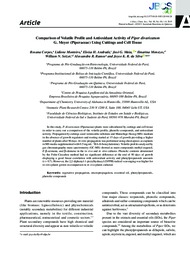Comparison of volatile profile and antioxidant activity of Piper divaricatum G. Meyer (Piperaceae) using cuttings and cell tissue.
Comparison of volatile profile and antioxidant activity of Piper divaricatum G. Meyer (Piperaceae) using cuttings and cell tissue.
Autoria: CORPES, R.; MONTEIRO, L.; ANDRADE, E. H.; MAIA, J. G.; MENEZES, I. C. de; SETZER, W. N.; RAMOS, A. R.; SILVA, J. K. R. da
Resumo: In this study, P. divaricatum (Piperaceae) plants were subcultured by cuttings and cell tissue in order to carry out a comparison of the volatile profile, phenolic compounds, and antioxidant activity. Propagation by cuttings used vermiculite substrate and Murashige-Skoog (MS) medium in the absence of growth regulators and rooting started at 15 days of growth providing a higher number of plants after 90 days. In vitro propagation was performed using shoot apices as explants in MS media supplemented with 0.5 mg mL-1 BA (6-benzyladenine). Volatile profiles analyzed by gas chromatography-mass spectrometry (GC-MS) showed as main compounds methyl eugenol, E-?-ocimene, and ?-elemene in the in vivo and in vitro cultures. Phenolic contents determined by the Folin-Ciocalteu method had no significant difference at the end of 90 days of growth displaying a good linear correlation with antioxidant activity and phenylpropanoids amounts (r > 0.7). However, the 2,2-diphenyl-1-picrylhydrazyl (DPPH) radical scavenging was higher for in vitro plants grown in comparison to in vivo plants cultured.
Ano de publicação: 2019
Tipo de publicação: Artigo de periódico
Unidade: Embrapa Amazônia Oriental
Palavras-chave: Antioxidante, Micropropagação, Piperaceae, Propagação Vegetativa
Observações
1 - Por padrão são exibidas publicações dos últimos 20 anos. Para encontrar publicações mais antigas, configure o filtro ano de publicação, colocando o ano a partir do qual você deseja encontrar publicações. O filtro está na coluna da esquerda na busca acima.
2 - Para ler algumas publicações da Embrapa (apenas as que estão em formato ePub), é necessário ter, no celular ou computador, um desses softwares gratuitos. Sistemas Android: Google Play Livros; IOS: iBooks; Windows e Linux: software Calibre.
Acesse outras publicações
Acesse a Base de Dados da Pesquisa Agropecuária (BDPA) para consultar o acervo completo das bibliotecas da Embrapa.

